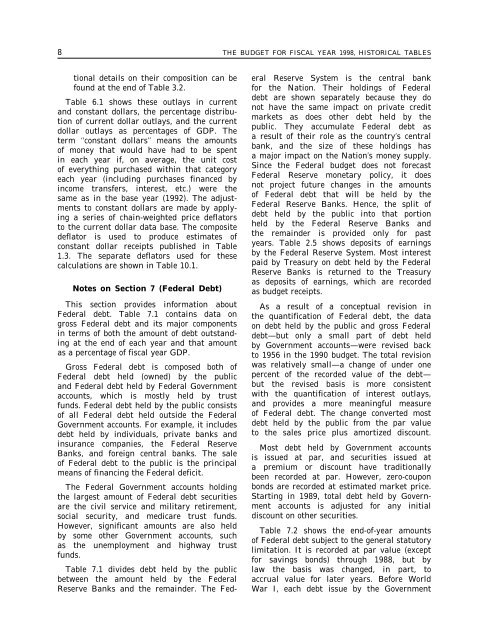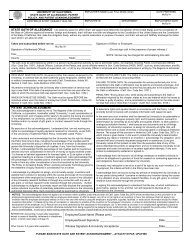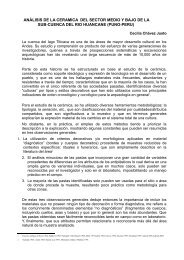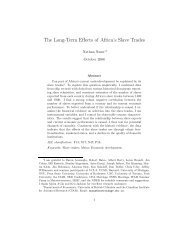EOP Historical Tables of the U.S. Budget - Social Sciences Division
EOP Historical Tables of the U.S. Budget - Social Sciences Division
EOP Historical Tables of the U.S. Budget - Social Sciences Division
Create successful ePaper yourself
Turn your PDF publications into a flip-book with our unique Google optimized e-Paper software.
8 THE BUDGET FOR FISCAL YEAR 1998, HISTORICAL TABLES<br />
tional details on <strong>the</strong>ir composition can be<br />
found at <strong>the</strong> end <strong>of</strong> Table 3.2.<br />
Table 6.1 shows <strong>the</strong>se outlays in current<br />
and constant dollars, <strong>the</strong> percentage distribution<br />
<strong>of</strong> current dollar outlays, and <strong>the</strong> current<br />
dollar outlays as percentages <strong>of</strong> GDP. The<br />
term ‘‘constant dollars’’ means <strong>the</strong> amounts<br />
<strong>of</strong> money that would have had to be spent<br />
in each year if, on average, <strong>the</strong> unit cost<br />
<strong>of</strong> everything purchased within that category<br />
each year (including purchases financed by<br />
income transfers, interest, etc.) were <strong>the</strong><br />
same as in <strong>the</strong> base year (1992). The adjustments<br />
to constant dollars are made by applying<br />
a series <strong>of</strong> chain-weighted price deflators<br />
to <strong>the</strong> current dollar data base. The composite<br />
deflator is used to produce estimates <strong>of</strong><br />
constant dollar receipts published in Table<br />
1.3. The separate deflators used for <strong>the</strong>se<br />
calculations are shown in Table 10.1.<br />
Notes on Section 7 (Federal Debt)<br />
This section provides information about<br />
Federal debt. Table 7.1 contains data on<br />
gross Federal debt and its major components<br />
in terms <strong>of</strong> both <strong>the</strong> amount <strong>of</strong> debt outstanding<br />
at <strong>the</strong> end <strong>of</strong> each year and that amount<br />
as a percentage <strong>of</strong> fiscal year GDP.<br />
Gross Federal debt is composed both <strong>of</strong><br />
Federal debt held (owned) by <strong>the</strong> public<br />
and Federal debt held by Federal Government<br />
accounts, which is mostly held by trust<br />
funds. Federal debt held by <strong>the</strong> public consists<br />
<strong>of</strong> all Federal debt held outside <strong>the</strong> Federal<br />
Government accounts. For example, it includes<br />
debt held by individuals, private banks and<br />
insurance companies, <strong>the</strong> Federal Reserve<br />
Banks, and foreign central banks. The sale<br />
<strong>of</strong> Federal debt to <strong>the</strong> public is <strong>the</strong> principal<br />
means <strong>of</strong> financing <strong>the</strong> Federal deficit.<br />
The Federal Government accounts holding<br />
<strong>the</strong> largest amount <strong>of</strong> Federal debt securities<br />
are <strong>the</strong> civil service and military retirement,<br />
social security, and medicare trust funds.<br />
However, significant amounts are also held<br />
by some o<strong>the</strong>r Government accounts, such<br />
as <strong>the</strong> unemployment and highway trust<br />
funds.<br />
Table 7.1 divides debt held by <strong>the</strong> public<br />
between <strong>the</strong> amount held by <strong>the</strong> Federal<br />
Reserve Banks and <strong>the</strong> remainder. The Federal<br />
Reserve System is <strong>the</strong> central bank<br />
for <strong>the</strong> Nation. Their holdings <strong>of</strong> Federal<br />
debt are shown separately because <strong>the</strong>y do<br />
not have <strong>the</strong> same impact on private credit<br />
markets as does o<strong>the</strong>r debt held by <strong>the</strong><br />
public. They accumulate Federal debt as<br />
a result <strong>of</strong> <strong>the</strong>ir role as <strong>the</strong> country’s central<br />
bank, and <strong>the</strong> size <strong>of</strong> <strong>the</strong>se holdings has<br />
a major impact on <strong>the</strong> Nation’s money supply.<br />
Since <strong>the</strong> Federal budget does not forecast<br />
Federal Reserve monetary policy, it does<br />
not project future changes in <strong>the</strong> amounts<br />
<strong>of</strong> Federal debt that will be held by <strong>the</strong><br />
Federal Reserve Banks. Hence, <strong>the</strong> split <strong>of</strong><br />
debt held by <strong>the</strong> public into that portion<br />
held by <strong>the</strong> Federal Reserve Banks and<br />
<strong>the</strong> remainder is provided only for past<br />
years. Table 2.5 shows deposits <strong>of</strong> earnings<br />
by <strong>the</strong> Federal Reserve System. Most interest<br />
paid by Treasury on debt held by <strong>the</strong> Federal<br />
Reserve Banks is returned to <strong>the</strong> Treasury<br />
as deposits <strong>of</strong> earnings, which are recorded<br />
as budget receipts.<br />
As a result <strong>of</strong> a conceptual revision in<br />
<strong>the</strong> quantification <strong>of</strong> Federal debt, <strong>the</strong> data<br />
on debt held by <strong>the</strong> public and gross Federal<br />
debt—but only a small part <strong>of</strong> debt held<br />
by Government accounts—were revised back<br />
to 1956 in <strong>the</strong> 1990 budget. The total revision<br />
was relatively small—a change <strong>of</strong> under one<br />
percent <strong>of</strong> <strong>the</strong> recorded value <strong>of</strong> <strong>the</strong> debt—<br />
but <strong>the</strong> revised basis is more consistent<br />
with <strong>the</strong> quantification <strong>of</strong> interest outlays,<br />
and provides a more meaningful measure<br />
<strong>of</strong> Federal debt. The change converted most<br />
debt held by <strong>the</strong> public from <strong>the</strong> par value<br />
to <strong>the</strong> sales price plus amortized discount.<br />
Most debt held by Government accounts<br />
is issued at par, and securities issued at<br />
a premium or discount have traditionally<br />
been recorded at par. However, zero-coupon<br />
bonds are recorded at estimated market price.<br />
Starting in 1989, total debt held by Government<br />
accounts is adjusted for any initial<br />
discount on o<strong>the</strong>r securities.<br />
Table 7.2 shows <strong>the</strong> end-<strong>of</strong>-year amounts<br />
<strong>of</strong> Federal debt subject to <strong>the</strong> general statutory<br />
limitation. It is recorded at par value (except<br />
for savings bonds) through 1988, but by<br />
law <strong>the</strong> basis was changed, in part, to<br />
accrual value for later years. Before World<br />
War I, each debt issue by <strong>the</strong> Government
















